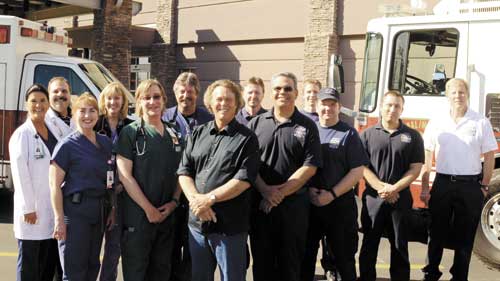APRIL 3, 2013
Teamwork, technology and efficiency save Cave Creek man
 Survivor Tom Taelman front and center, flanked by Rural/Metro Fire and Rescue responders on the right and Scottsdale Healthcare Thompson Peak Medical teams on the left.
Survivor Tom Taelman front and center, flanked by Rural/Metro Fire and Rescue responders on the right and Scottsdale Healthcare Thompson Peak Medical teams on the left.
SCOTTSDALE – Cave Creek resident Tom Taelman recognizes that both good fortune and great medical teams saved his life. Saturday, Jan. 5, began like a typical morning, but as he started making his coffee something felt like it was stuck in his chest. When he tried to stretch, he realized it was something much worse.
Taelman was suffering from a ST-Elevation Myocardial Infarction (STEMI), a more severe type of heart attack. Time is crucial to surviving a STEMI heart attack, and Taelman’s clock started ticking.
“I called 9-1-1 and I felt like they were here almost immediately,” said Taelman of the Rural/Metro Fire and Rescue teams who arrived to care for him around 6 a.m. that Saturday.
Fortunately, Tom lives near a Rural/Metro station where talented crews are trained in advanced STEMI alert protocols.
“We performed a 12-Lead Electrocardiogram (EKG) when we arrived and what we saw was a STEMI,” said Rural/Metro Captain Conrad Lopez. “We knew we had to call Scottsdale Healthcare and relay the data immediately to get the teams ready for him.”
The trip from his home to the hospital seemed like mere seconds to Taelman. That sense of immediacy would continue throughout his treatment; and not by accident.
“I just remember asking, ‘How did we get here so fast?’ to the medics,” said Taelman. “I felt like I was treated almost immediately.”
He was treated in almost record time for a STEMI from when he reached the doors of the hospital and first treated by emergency physician, Joyce Schmidt, MD, and then in the cath lab when the balloon was inserted by cardiologist, Lawrence J. Cook. MD.
The national best practice for a STEMI “Door to Balloon,” or the amount of time between a patient entering the emergency room until a balloon is inserted to open the blocked artery, is 90 minutes. In Taelman’s case, his Door to Balloon time was 35 minutes; nearly one-third of what is considered to be the best national standard for care.
Taelman also considers himself lucky that the closest hospital, Scottsdale Healthcare Thompson Peak Hospital, and Rural/Metro have been working together since the hospital opened and have an outstanding working relationship.
“The biggest element to having this kind of success is trust between the EMS professionals and the Emergency Department,” said RN, Nurse Manager of Emergency Services and Respiratory Therapy at Scottsdale Healthcare Thompson Peak Hospital, Jane Taylor. “The hospital team required for a STEMI patient is huge, involving several departments. That relationship and trust with our EMS partners is essential. The alert from Rural/Metro on their way to the hospital that morning facilitated the incredibly short door to balloon time for Mr. Taelman.”
That trust between Rural/Metro, which has been serving Cave Creek since 1965, and Scottsdale Healthcare Thompson Peak Hospital is a result of a commitment to clinical excellence and outstanding patient care together, since the hospital opened five years ago.
“The only luck involved was that I am lucky I live where I do,” said Taelman.



